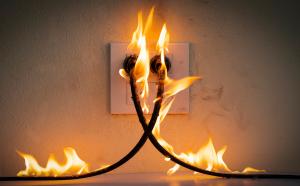
 Plastic surfaces are particularly tricky to restore after a fire because of how they react to heat and smoke”
Plastic surfaces are particularly tricky to restore after a fire because of how they react to heat and smoke”— Earl Carr, Jr. HAMMOND, LA, UNITED STATES, October 11, 2024 /EINPresswire.com/ -- In the wake of a fire, property owners face the daunting task of cleaning and restoring their homes or businesses. While many surfaces can be addressed with common fire damage restoration techniques, plastic materials present unique challenges due to their chemical composition and response to high heat. Earl Carr, Jr., president of Gulf 52, a fire damage restoration company based in Hammond, Louisiana, sheds light on why plastic surfaces require special care and attention during the cleaning process.
Plastics are commonly found throughout most properties, in items ranging from kitchenware and furniture to appliances, electronics, and building materials. When exposed to the intense heat and smoke of a fire, these surfaces can undergo a series of chemical reactions that not only damage the material itself but also make the cleaning process more complicated.
“Plastic surfaces are particularly tricky to restore after a fire because of how they react to heat and smoke," says Carr. "The challenge is not just the surface-level soot and residue, but also the changes in the plastic's structure that make it more difficult to clean effectively."
How Fire Affects Plastic Surfaces
When a fire occurs, plastics undergo a transformation due to their sensitivity to heat. Unlike wood, metal, or other natural materials, plastics are made up of synthetic polymers that can melt, warp, and release toxic fumes when burned. The impact of heat on plastic surfaces can be severe, leading to structural changes that are difficult to reverse.
One of the main issues is that plastic can soften and deform even at relatively low temperatures, well before the flames make contact. This thermal sensitivity causes the plastic to absorb smoke particles and soot more deeply, embedding them within the material and making it harder to clean. Additionally, the melted or charred surface of the plastic can develop a sticky, greasy residue that traditional cleaning methods may struggle to remove.
Another factor is the release of toxic chemicals when plastic burns. These chemicals can further damage the plastic surface and complicate the restoration process. Plastics such as PVC (polyvinyl chloride), commonly found in pipes and building materials, release corrosive hydrochloric acid when burned, which can damage other nearby materials and spread further contamination throughout the property.
The Challenges of Cleaning Soot and Smoke from Plastic Soot and smoke are the most immediate byproducts of a fire, and they are often the primary focus of fire damage restoration . However, on plastic surfaces, soot and smoke can pose a greater challenge than on other materials. The reason for this lies in the porous and reactive nature of plastics. Soot, which is composed of fine carbon particles, sticks easily to plastic surfaces and can be absorbed into the material. Smoke, which contains volatile organic compounds (VOCs) and acidic components, can penetrate deep into plastics and leave behind odors that are difficult to neutralize.
Cleaning soot from plastic surfaces is more complex because of the way it bonds to the material. Standard dry cleaning methods may not be sufficient to remove soot from plastic, as the particles can become embedded in the softened surface. Chemical sponges and specially formulated cleaning agents may be necessary to effectively lift the soot without causing further damage to the plastic.
Smoke damage to plastic surfaces often requires odor-neutralizing treatments, such as ozone or thermal fogging, to break down the smoke particles trapped within the material . However, these treatments need to be carefully applied to avoid causing additional harm to the plastic's structure.
Heat Damage and Structural Changes Beyond soot and smoke, heat damage is a significant factor when dealing with plastic surfaces. The intensity of heat during a fire can cause plastic to melt, warp, or even burn completely. When plastic melts, it can become sticky and fuse with other materials, making the cleanup process more difficult. If the plastic has warped or lost its shape, it may be irreparably damaged and require replacement rather than restoration.
Structural changes in plastic due to heat can also affect how well the surface can be cleaned. Once plastic has melted or charred, its surface texture changes, creating an uneven or brittle layer that is harder to scrub or treat without further damaging the material. These changes necessitate a tailored approach to cleaning and restoration, as traditional methods may not be effective or safe for these altered surfaces.
The Importance of Professional Assessment and Cleaning Techniques Restoring plastic surfaces after a fire requires an understanding of both the material's chemical properties and the right techniques for addressing the damage. Each type of plastic has different sensitivities to heat, chemical exposure, and cleaning methods, so it is important to assess the specific damage and tailor the restoration process accordingly.
In some cases, specialized cleaning agents designed for plastic may be needed to effectively remove soot and smoke residues without causing further harm to the material. In other situations, odor-neutralizing treatments must be carefully applied to address smoke damage while preserving the integrity of the plastic surface. For plastics that have suffered significant heat damage, replacement may be the only viable option.
A professional fire damage restoration team brings the expertise and tools necessary to safely and effectively clean and restore plastic surfaces. They are trained to assess the extent of damage, select the appropriate cleaning methods, and ensure that all health and safety considerations are met during the process. Proper ventilation, personal protective equipment, and careful handling of materials are essential when working with fire-damaged plastics, especially those that have released toxic fumes.
Conclusion Plastic surfaces present unique challenges in fire damage restoration due to their sensitivity to heat, tendency to absorb soot and smoke, and the structural changes they undergo during a fire. The sticky residue left behind by melted plastic, the difficulty of removing deeply embedded soot, and the odors trapped within the material all make the cleaning process more complicated than with other surfaces.
To effectively restore plastic surfaces after a fire, a professional assessment is necessary to determine the best approach. Proper cleaning techniques, specialized agents, and, in some cases, odor-neutralizing treatments are crucial to achieving thorough restoration while preserving the integrity of the material. Gulf 52 provides specialized expertise in fire damage restoration, ensuring that plastic and other affected materials are cleaned and treated effectively and safely.
Morgan ThomasRhino Digital, LLC+1 504-875-5036email us hereVisit us on social media:Facebook
Legal Disclaimer:
EIN Presswire provides this news content "as is" without warranty of any kind. We do not accept any responsibility or liability for the accuracy, content, images, videos, licenses, completeness, legality, or reliability of the information contained in this article. If you have any complaints or copyright issues related to this article, kindly contact the author above.
You just read:
News Provided By
October 11, 2024, 17:18 GMT
EIN Presswire's priority is author transparency. We do our best to weed out false and misleading content. The content above is the sole responsibility of the author who makes it available. If you have any complaints, kindly contact the author above.
Originally published at https://www.einpresswire.com/article/751028244/the-challenges-of-cleaning-plastic-surfaces-after-a-fire-key-considerations-for-restoration






